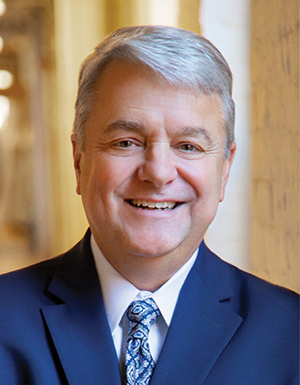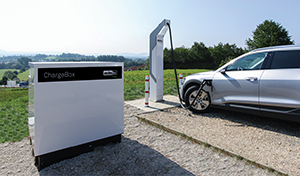 John Tuccillo
John Tuccillo
Global Head of Corporate and Government Affairs
ADS-TEC Energy
www.adstec-energy.com
Convenience retailers have been hearing about the coming electric vehicle (EV) revolution for years. Today, buoyed by unprecedented industry and government support, consumer and fleet EVs are forecast to number more than 11.6 million by 2025, which is up from 6.7 million in 2021. These combined steps and support contribute to EVs becoming more cost effective and practical. This means the current demand for ultra-fast charging stations will accelerate further. Despite this, the U.S. still lags behind Europe in the number of EV chargers available to the public and EVs on the road.
That will likely change soon, given the Biden Administration’s National Electric Vehicle Infrastructure Formula Program (NEVI), which includes a goal of having EV chargers every 50 miles and no more than one mile off high-use corridors. “The logistics and cost of adding EV charging capabilities to their forecourt have pushed many retailers to abandon hope of being able to provide this service,” said John Tuccillo, global head of corporate and government affairs, ADS-TEC Energy. “However, technology advancements have eased many of the barriers convenience retailers face, opening up a potential revenue stream for the industry.”
This presents a golden opportunity for convenience retailers—including those that offer fuel—to provide ultra-fast EV charging stations—and the food and drinks that EV drivers want as they wait.
TECHNOLOGY BASICS
There are three levels of EV charging. Levels 1 and 2 are typically found in homes, as the charging stations use readily available AC power. Despite convenient install, these chargers take hours to fully charge a vehicle. Level 3—or Direct Current Fast Charging (DCFC)—can charge up to 60-80% of a vehicle’s battery in approximately 30 minutes. That’s an improvement but still significantly longer than the 10 minutes or less a typical consumer would expect to spend at a traditional service station. On top of that, DCFC requires access to high-powered service (typically 300kW).
Even as EVs are becoming more widely available, the demand for fast, convenient charging is nowhere near being met."
Additionally, installing the DCFC stations can create a triple-hit with large financial investments in installation and charging equipment, plus permit requests and weeks of disruption as forecourts are dug up to accommodate the chargers. Retailers also need to ensure their infrastructure provides access to high-powered service (typically 300kW). In many places, this means requesting (and paying for) the higher powered electrical service upgrades and extensions, which could take months and require additional digging and installation, followed by electrical rate hikes given the site demand increases.
“Even as EVs are becoming more widely available, the demand for fast, convenient charging is nowhere near being met,” said Tuccillo. “Part of the challenge lies in the existing electrical grid, which isn’t prepared to meet the need for high-output, fast-charging stations.”
Unless the charging station is installed near high-power transmission and distribution sources, or along a major freeway corridor, it’s likely limited in its ability to access the high-powered service necessary to offer what the EV industry refers to as fast charging.
One solution is ADS-TEC Energy’s battery-buffered, ultra-fast ChargeBox charging system, which can connect to the current low-to-medium-power grid most retailers operate on. This technology allows convenience stores to facilitate a transition to EVs in an economical way, so they can quickly ramp up to provide ultra-fast charging.
The genius of ADS-TEC Energy’s battery-buffering technology is how it pulls from existing electrical sources—which can be as low as a 50kW supply—and transforms it into the higher voltage charge needed for electric vehicles. “Our technology also allows the retailer to provide one charging model that can meet the demands of each EV make and model,” said Tuccillo.
ADS-TEC Energy’s ChargeBox enables customized, ultra-fast charging using the existing power from the area’s electrical grid without disruptive, expensive grid expansion. Its internal battery buffer is filled from the existing electric grid on a lower power input rate.
 ChargeBox charging a 150kW Audi e-tron in minutes instead of hours, with up to 320kW available, on existing power-limited grids without additional electrical infrastructure upgrades.
ChargeBox charging a 150kW Audi e-tron in minutes instead of hours, with up to 320kW available, on existing power-limited grids without additional electrical infrastructure upgrades.
It then discharges the stored power at the higher output and rate needed to recharge the connected EV at its individual requirement.
The ChargeBox automatically registers how much current the plugged-in vehicle needs and adjusts the output accordingly. When a high-demand vehicle like a Porsche Taycan plugs in, the ChargeBox delivers up to 320kW, well beyond what the 270kW Taycan needs. When a Chevy Volt plugs in, the ChargeBox delivers the lower charge level that the Volt requires. The end user receives an ultra-fast charge on site as the ChargeBox recharges itself, ensuring it’s always ready for the next customer.
The ChargeBox also operates on a lower cost by minimizing peak demand charges.
Standard, non-battery-buffering DC chargers that require 300kW of power can be subject to peak demand charges, especially if more than one vehicle is charging at the same time.
A RETAIL SOLUTION
With its decentralized battery-buffering platform and compact size, the ADS-TEC Energy ChargeBox can be easily situated on a retailer’s existing forecourt without disrupting operations. “Our ChargeBox yields a substantial 30% lower total cost of ownership compared with other EV chargers, which can help retailers become an EV destination quicker,” said Tuccillo. “In addition, the ChargeBox is compatible with many EVs and can be installed in a few weeks, allowing retailers a faster return on their investment as well as minimal disruption to their normal business.”
Partnering with a company like JOLT can give the retailer quicker and more affordable access to chargers."
E-mobility startup JOLT Energy has partnered with ADS-TEC Energy to accelerate the deployment of ultra-fast charging stations in major cities in Europe and the United States. Five thousand ultra-fast charging stations are planned in Europe and the U.S. by 2027. “The introduction of ultra-fast charging is progressing too slowly due to the enormous investments,” said Maurice Neligan, CEO, JOLT Energy Group. “That’s why, from our point of view, you have to leverage all the possibilities that exist to finance a very fast e-charging infrastructure.”
Currently, installation at gas stations has begun, with plans to put in 120 ultra-fast chargers from ADS-TEC Energy at 60 ESSO locations operated by EG Group in key German cities within the next six to eight months. “For us, speed of deployment and the flexibility to provide high quality ultra-fast charging in large population centers is key. The German charger and battery technology from ADS-TEC Energy is best in class, in terms of power, quietness and charging time,” said Neligan.
He pointed out how EV charging requires a different business model than selling fuel or snacks. “While on the surface the entire process—from length of customer stay to payment to dealing with electricity—appears the same, it’s radically different,” Neligan said. “EV charging is highly digital, whereas mineral oil and fast-food sales, for example, are quite analog in the sales process.”
Introducing ultra-fast charging into the existing footprint of a convenience store requires getting adequate electricity to the site as well as finding an affordable way to add EV chargers. “For most gas station and convenience store operators already working on tight margins, figuring out how to finance this level of equipment is often too challenging,” Neligan said. “Partnering with a company like JOLT can give the retailer quicker and more affordable access to chargers.”
JOLT Energy sees adding EV chargers to existing convenience forecourts as a major advantage. “The EV driver is captive for a certain period of time, usually 20 minutes,” Neligan said. “During this time, they generally grab coffee or snacks, which are good margin categories for convenience retailers.”
With technological advancements like ADS-TEC Energy’s ChargeBox, convenience retailers can more easily join the EV revolution and provide another needed service to their customers. EVs are here to stay, and the more retailers can accommodate these drivers with ultra-fast charging solutions like ADS-TEC Energy’s ChargeBox, the more EV motorists will view convenience stores as their driving partners.